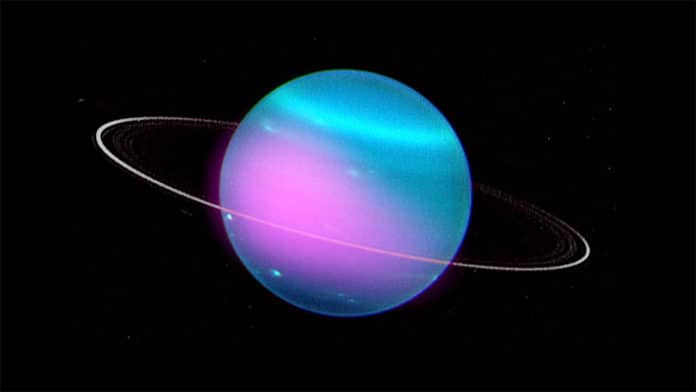For the first time, scientists have discovered that Uranus is emitting X-rays. X-rays have been detected in most solar system planets but not in the case of giant ice planets of our solar system like Uranus and Neptune.
Uranus is the seventh planet from the Sun, having two sets of rings around its equator and four times the Earth’s diameter.
The astronomers are currently relying on telescopes such as Chandra and Hubble space telescopes which are near Earth for the study of Uranus as only spacecraft Voyagar2 has flown to Uranus to date.
In a new study, researchers have used observations taken by Chandra’s observatory in 2002 and 2017.
In 2002’s research, they have observed clear detection of X-rays while possible flair of X-rays obtained in 2017’s research.
The main cause of Uranus remitting X-rays is the Sun. Astronomers have observed that Jupiter and Saturn scatter X-ray light given off by Sun; similarly, Earth also scatters sunlight.
“While the authors of the new Uranus study initially expected that most of the X-rays detected would also be from scattering, there are tantalizing hints that at least one other source of X-rays is present,” according to a NASA release.
“If further observations confirm this, it could have intriguing implications for understanding Uranus.”
One possibility of emission of X-rays is that rings of Uranus are producing X-rays themselves, which is a similar case to Saturn’s ring. The presence of charged particles such as electrons and protons in Uranus’ nearby environment and their collision with rings could cause rings to glow in X-rays. Another possibility is that at least some of the X-rays are coming from auroras of Uranus. Auroras happen when high-energy particles interact with the atmosphere. For example, light shows in the sky from Earth.
Uranus’s spin axis and magnetic field’s unusual orientation make Uranus an exciting target for X-ray observation. Most of the planets have their rotation and magnetic field axes perpendicular to the plane of their orbit. The rotation axis of Uranus is nearly parallel to its path around Sun. Determining the sources of the X-rays from Uranus could help astronomers better understand how more exotic objects in space, such as growing black holes and neutron stars, emit X-rays.
Journal Reference
- W. R. Dunn, A Low Signal Detection of X-Rays From Uranus. Journal of Geophysical Research: Space Physics, 2021; Volume 126, Issue 4 DOI: 10.1029/2020JA028739
